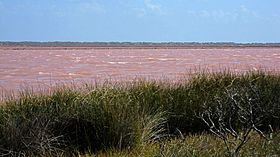Hutt Lagoon facts for kids
Quick facts for kids Hutt Lagoon |
|
|---|---|

View of Hutt Lagoon from south east shore
|
|
| Location | Mid Western Australia |
| Coordinates | 28°08′S 114°13′E / 28.133°S 114.217°E |
| Type | Marine lake |
| Basin countries | Australia |
| Max. length | 14 km (8.7 mi) |
| Max. width | 2.3 km (1.4 mi) |
| Max. depth | 0.65 m (2 ft 2 in) |
| Surface elevation | below sea-level |
Hutt Lagoon is a special kind of salt lake found near the Indian Ocean in Western Australia. It's known for its amazing pink color! This lake is about 2 kilometers (1.2 miles) north of where the Hutt River meets the ocean.
Contents
Where is Hutt Lagoon?
Hutt Lagoon is a long, narrow lake. It sits in a low area between sand dunes, right next to the coast. The small town of Gregory is located between the ocean and the lake's southern side. A road called George Grey Drive runs along the eastern edge of the lake. This road connects the towns of Northampton and Kalbarri.
The lake is about 14 kilometers (8.7 miles) long. It stretches from northwest to southeast, running parallel to the coast. It is about 2.3 kilometers (1.4 miles) wide. Hutt Lagoon is part of a bigger wetland system. This system is important enough to be listed as a special wetland area.
How the Lake Works
Hutt Lagoon is a "marine lake," which means it's a salt lake connected to the ocean. Most of the lake's area is a few meters below sea level. A natural sand ridge and dunes separate it from the Indian Ocean.
Water Sources
Like some other salt lakes, Hutt Lagoon gets its water from two main places:
- Ocean water: Seawater seeps into the lake all year round through the sandy barrier.
- Rainwater: During the wet winter season, more water comes in from underground springs, which are fed by rain.
Climate and Salt
The area around Hutt Lagoon has a Mediterranean climate. This means it has wet winters and dry summers. The average rainfall is about 449 millimeters (17.7 inches) per year, mostly from May to August. However, the average evaporation rate is very high, about 2445 millimeters (96.3 inches) per year.
These conditions cause salt to build up in the lake. During the dry summer, about 95% of the lake's surface turns into a dry salt flat.
History of Hutt Lagoon
The explorer George Grey was the first European to name Hutt Lagoon. He camped near the lake on April 4, 1839. He was on his second trip along the Western Australian coast. Grey thought the lake was a large river and estuary. He named it after William Hutt, who was a British politician. William Hutt was also the brother of John Hutt, who became the second Governor of Western Australia.
Later, in January 1840, Governor Hutt sent a ship to explore the "river and estuary" Grey had described. However, the ship's captain reported that the Hutt River was dry at its mouth. They could not find the large estuary Grey had mentioned. This showed that what Grey saw was actually a seasonal lake, not a permanent river mouth.
Special Resources from Hutt Lagoon
Hutt Lagoon is famous for its unique resources.
Pink Color and Beta-Carotene
Hutt Lagoon is a "pink lake." Its amazing red or pink color comes from tiny living things called algae. This specific algae is called Dunaliella salina. It produces a special orange-red substance called beta-carotene.
Beta-carotene is very useful! It's used as a natural food coloring. It's also a source of vitamin A, which is important for our health. Hutt Lagoon has the world's largest farm for this microalgae. It uses 250 hectares (618 acres) of artificial ponds to grow Dunaliella salina.
Brine Shrimp
The lake is also home to tiny creatures called Artemia parthenogenetica brine shrimp. These shrimp are harvested from Hutt Lagoon. They are used as a special food for:
- Prawn and fish farms
- The aquarium fish trade
Salt and Gypsum
In 1854, another explorer named Augustus Charles Gregory noticed the large amounts of salt at Hutt Lagoon. He also saw the good quality of gypsum deposits on the western side of the lake. Gypsum is a mineral used in plaster and fertilizer.
Salt from Hutt Lagoon was shown at the Sydney Intercolonial Exhibition in 1873 and received high praise. Gypsum from the lake also won a Bronze Medal. Hutt Lagoon salt was also displayed at the Melbourne Exhibition in 1880.
A company called Port Gregory Saltworks started shipping salt from the lake in 1908. They produced about 4,000 tons of salt each year. The salt operation continued until 1924.
See also



